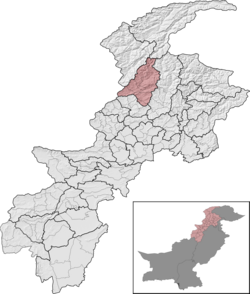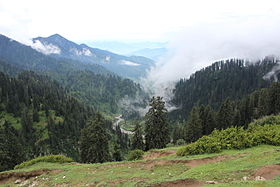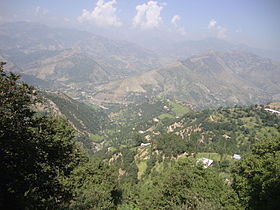Upper Dir District (Pashto: پورتنۍ دیر ولسوالۍ, Urdu: ضلع دیر بالا) is a district located in the Malakand Division of Khyber Pakhtunkhwa province of Pakistan. The city of Dir is its district headquarter. Geographically, it is located in the northern part of Pakistan. It borders with the Chitral district on the north, Afghanistan on the northwest, the Swat district on the east, and the Lower Dir district on the south. It shares 40 to 50 kilometers border with Afghanistan.
Upper Dir District ضلع دیر بالا پورتنۍ دیر ولسوالۍ | |
|---|---|
 Upper Dir District (red) in Khyber Pakhtunkhwa | |
| Country | |
| Province | |
| Division | Malakand |
| Established | 1996 |
| Headquarters | Dir |
| Government | |
| • Type | District Administration |
| • Deputy Commissioner | Gohar Zaman Wazir (BPS-18 PAS) |
| • District Police Officer | Mushtaq Ahmad (BPS-18 PSP) |
| • District Health Officer | N/A |
| Area | |
| • District of Khyber Pakhtunkhwa | 3,699 km2 (1,428 sq mi) |
| Population | |
| • District of Khyber Pakhtunkhwa | 946,421 |
| • Density | 260/km2 (660/sq mi) |
| • Urban | 44,165 |
| • Rural | 902,256 |
| Time zone | UTC+5 (PST) |
| Number of Tehsils | 6 |
| Main language(s) | Pashto ,[2]: 21 Gawri |
| Website | dirupper |
History

Dir was home to various popular civilizations. It has been the place where the Aryans, the Budhists, and the Mughals survived. It was also a home to the Gandhara civilization. It was invaded by Alexander The Great.
In the sixteenth century, it was invaded by the Yousafzai tribe of the Pashtuns.[citation needed]
In 1898, Yousafzai Pashtun Muhammad Sharif Khan was declared the Nawab of Dir. He was succeeded by his son Nawab Aurang Zeb Khan in 1904, who ruled until his death in 1925. Subsequently, his son Shah Jehan Khan succeeded him and ruled the state for almost 35 years.[citation needed] At the time of the independence of Pakistan, in 1947, Dir was still a princely state, separated from Pakistan. It was no later than 1969, when it was annexed with the Khyber Pakhtunkhwa province of Pakistan. [3] Till 1996, Dir was a unit combined district. But in 1996, the Dir District was divided into Upper and Lower Dir districts.
Demographics
| Year | Pop. | ±% p.a. |
|---|---|---|
| 1972 | 251,045 | — |
| 1981 | 362,565 | +4.17% |
| 1998 | 575,858 | +2.76% |
| 2017 | 947,401 | +2.65% |
| Sources:[4] | ||
According to the 2017 Census of Pakistan, Upper Dir district had 120,228 households and a population of 946,421.[1] Upper Dir had a sex ratio of 1030 females per 1000 males and a literacy rate of 46.09% - 64.84% for males and 28.85% for females. 44,100 (4.65%) lived in urban areas. 37.29% of the population was under 10 years of age. 471 (0.05%) of the people in the district were from religious minorities.[1]
Pashto is the predominant language, spoken by 90.78% of the population. Other languages, mainly various Kohistani languages, are spoken by 8.60% of the population.
Tribes
The people groups of the district are various Pashtun tribes of Afghan origin among other clans that settled in the region. These include the following tribes[5]
Administration
Upper Dir District has 4 Tehsils.[6]
Wari and Larjam tehsils are part of newly created District Central Dir District.
National Assembly
This district is represented by one elected MNA (Member of National Assembly) in Pakistan National Assembly. Its constituency is NA-5 (Upper Dir).[7]
| Member of National Assembly | Party Affiliation | Year |
|---|---|---|
| Molana Asad Ullah | Muttahida Majlis-e-Amal | 2002 |
| Najum-din Khan | Pakistan Peoples Party | 2008 |
| Sahibzada Sebgat Ullah | Pakistan Tehreek-e-Insaf | 2018 |
Provincial Assembly
In the provincial assembly of Khyber Pakhtunkhwa, there are three seats for the Upper Dir district. Its constituency is PK-10, PK-11 and PK-12.
| Member of Provincial Assembly | Party Affiliation | Constituency | Year |
|---|---|---|---|
| Malak Badsha Saleh | Pakistan Peoples Party Parliamentarians | PK-10 Upper Dir-I | 2018 |
| Sahibzada Sanaullah | Pakistan Peoples Party Parliamentarians | PK-11 Upper Dir-II | 2018 |
| Inayat Ullah | Muttahida Majlis-e-Amal | PK-12 Upper Dir-III | 2018 |
Towns

Except for the town of Dir and a number of rapidly growing towns along the main road, the population is rural, scattered in more than 1200 villages in the deep narrow valleys of the Panjkora and its tributaries.
Of these, notable villages are
Division of Dir

Popular places[8]
See also
References



